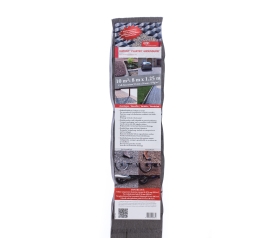Geotextile grid DuPont GroundGrid 55/50; 10 sq. m.
This is an economically useful solution, how to stabilize soil. It suits especially well to protect the used surface of land from washing out in case of strong rain or floods. When the geotextile grid is used, rainfall does not flow on the surface, but seeps into the land evenly.
 Usage:
Usage:
• It suits well for drained surface of land.
• It stabilizes surface of gravel coating in parking lots and paths.
• It protects the coasts of slopes or ponds from erosion.
• DuPontTM GroundGridTM is an innovative solution instead of grass on parking lots and paths.
• It suits perfectly to arrange walking and cycleways.
• It is used for golf and sport fields.
Characteristics:
• Geotextile grid is made from 100% polypropylene coils.
• The cell’s size is 55 mm or 110 mm.
• The cell’s height is 50 mm or 100 mm.
• It does not rot or get moldy.
Advantages:
• Easy to transport.
• Possible vertical and horizontal filtration.
• Reduced hazard of damage caused by floods or rainfall’s flow.
• Flexible – may be easily cut to necessary size.
• Service time of the product: exceeds 25 years; the material has to be covered by gravel in full.
• Suitable for intensive traffic.
• The product is easily recycled.
I nstallation recommendations:
nstallation recommendations:
1. Preparation of substratum:
• The substratum has to be smooth (without any big hollows or large stones).
• The depth of the substratum has to be such that when the comb is put above it, 3-5 cm of coating could be filled up.
• If the basis is not strong, it is recommended to lay geotextile Typar under the grid.
2. Laying of grid :
• The grid is spread up to 8m length and 1,25m width, and the edges are fastened with pins.
• Separate pieces of grid are interconnected by metal studs.
• The grid may be cut to the needed size.
• The geotextile grid does not create lifting power. It is just the basis for filling. During the installation it is not allowed to walk on it. Strong rugs put on the grid protect against damages (Fig. 2.).
3. Filling of the grid:
• • The quarried stones or gravel may be used to fill the grid’s meshes.
• It is important not to allow big stones between the grid and the substratum, i.e. straight construction has to be maintained. If big stones get under the grid, they have to be removed, the grid has to be straightened and only then the started works may be continued.
• In order not to raise the grid from the substratum’ surface, it is recommended to press it by additional weight before the coating is poured (wooden board, metal bar, etc.) (Fig. 3.)
• It is allowed to walk on the grid only when it is filled with the selected coating to the top.
• When the coating is put, let it get packed. If hollows appear after several days, pour the coating additionally and level it (Fig. 5).
Technical characteristics
|
Parameters |
Standard |
Unit |
55 / 50 |
110 / 50 |
| Material’s weight |
EN ISO 9864 |
g / m² |
190 |
290 |
| Thickness2kN/m² |
EN ISO 9863-1 |
Mm |
0,54 |
0,75 |
| Resistance to stretching |
EN ISO 10319 |
kN/m |
13 |
21 |
| Elongation |
EN ISO 10319 |
% |
55 |
55 |
| Mesh’s size O90W |
EN ISO 12956 |
µm |
80 |
70 |
| Water permeability |
EN ISO 11058 |
mm/s |
35 |
15 |
Assortment of geotextile grid:
|
|
Name |
Size of comb’s cell |
Material’s thicknes |
Covered area |
Grid’s weight |
|
V |
HC 55/50 |
55/50 |
190 g/m² |
1,25m x 8m (10m² ) |
4,7 kg. |
|
X |
HC 55/100 |
55/100 |
190 g/m² |
1,25m x 8m (10m² ) |
9,5 kg. |
|
X |
HC 110/50 |
110/50 |
290 g/m² |
1,25m x 8m (10m² ) |
3,5 kg. |
|
X |
HC 110/100 |
110/100 |
290 g/m² |
1,25m x 8m (10m² ) |
6,9 kg. |



